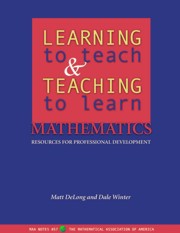Book contents
- Frontmatter
- Preface
- Contents
- 1 The Professional Development Program
- 2 How to Use this Book
- 3 An Orientation Session for the Beginning of the Semester
- 4 Making In-class Groups Work
- 5 Getting Students to Read the Textbook
- 6 Assessing and Evaluating Students' Work
- 7 Managing Homework Teams
- 8 Teaching During Office Hours
- 9 Establishing and Maintaining Control in Your Classroom
- 10 Proctoring Tests and Examinations
- 11 Teaching with Calculators and Computers
- 12 Making Lesson Plans
- 13 Strategies for Motivating Students
- 14 Dealing With Difficult Instructor-Student Situations
- 15 End-of-Semester Administration
- 16 Adapting Materials and Designing Your Own Meetings
- 17 Classroom Visits
- A Tips for Running Meetings
- B The Michigan Introductory Program
- Bibliography
11 - Teaching with Calculators and Computers
- Frontmatter
- Preface
- Contents
- 1 The Professional Development Program
- 2 How to Use this Book
- 3 An Orientation Session for the Beginning of the Semester
- 4 Making In-class Groups Work
- 5 Getting Students to Read the Textbook
- 6 Assessing and Evaluating Students' Work
- 7 Managing Homework Teams
- 8 Teaching During Office Hours
- 9 Establishing and Maintaining Control in Your Classroom
- 10 Proctoring Tests and Examinations
- 11 Teaching with Calculators and Computers
- 12 Making Lesson Plans
- 13 Strategies for Motivating Students
- 14 Dealing With Difficult Instructor-Student Situations
- 15 End-of-Semester Administration
- 16 Adapting Materials and Designing Your Own Meetings
- 17 Classroom Visits
- A Tips for Running Meetings
- B The Michigan Introductory Program
- Bibliography
Summary
The widespread availability of affordable graphing calculators and computers running powerful computer algebra systems (CAS) is changing the way elementary mathematics is taught. Research in mathematics education (see the suggested readings at the end of this chapter for examples) indicates that the careful use of appropriate technology can help students to achieve learning outcomes that are rare in more traditional mathematics courses. Graphing calculators and CAS have been likened to the microscopes of a biology lab. Just as students can use microscopes to directly observe the working of organisms and other biological systems, calculators and computers can be used by students to explore mathematics. Just as personal observation of the behavior and structure of biological systems can make basic principles of physiology and anatomy more concrete for students, observation of the behavior and structure of mathematical phenomena can make abstract mathematical concepts more concrete for the students.
Nationwide, some instructors have reservations about incorporating such technology into the classroom. Critics of the use of technology in mathematics classes include that the net effect will be that students will fail to learn any mathematics, instead they will simply become adept at using the technology without developing any substantial understanding of any mathematical concepts. Another frequently heard criticism (particularly of calculators) is that the technology will become a “crutch” for students.
These are potentially valid criticisms of the use (perhaps “misuse” is more accurate) of technology in mathematics courses.
Information
- Type
- Chapter
- Information
- Learning to Teach and Teaching to Learn MathematicsResources for Professional Development, pp. 133 - 148Publisher: Mathematical Association of AmericaPrint publication year: 2002
